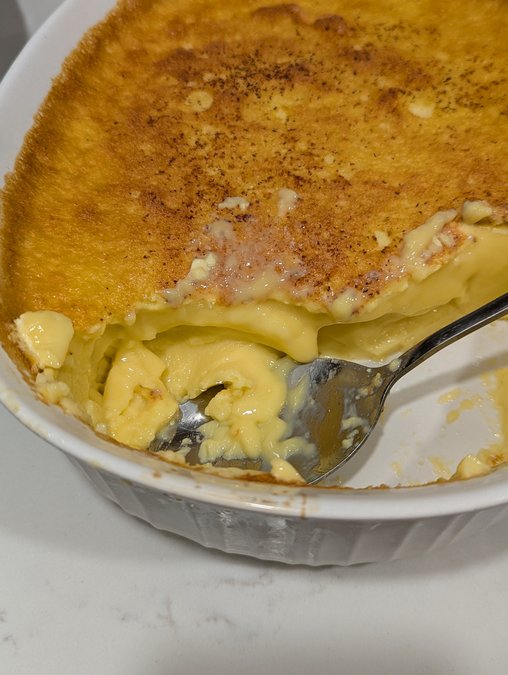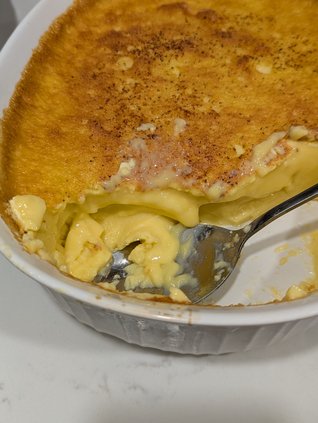“Ooh, we love custard, and my recipe is perfect.” “Wait no, I have the perfect custard!” “And here we are pretty sure our custard is the best ...”
I was chatting about this and that with a few friends, when we stumbled onto the seemingly-at-odds fact that we each had The Best Custard. As moms do, fueled both by culinary interest and family-feeding necessity, we had been swapping recipe ideas back and forth; up until this point, while we exhibited enthusiasm for particular dishes we enjoyed making, I don’t think anyone had claimed possession of the best version.
As soon as we hit on custard, however, something changed. All four of us chimed in matter-of-factly that the recipe we use is supreme. There was no antagonism or boasting, rather more humor and curiosity that we all felt so secure in our family’s version of this particular concept.
In fact, I think custard can be held so tightly (not literally, that gets messy) for the same reason that it can be held so loosely: its simplicity. It’s milk, eggs, and sugar. How could we get too precious about that?
Now obviously there are variations, and I will never be one to turn my nose up at pumpkin custard, rhubarb custard, sweet corn custard, et cetera ad infinitum. You may have noticed I love to play with flavors and challenge some traditions, always tinkering and adding, and the concept of custard is no safer than any other. I love bold, punchy, exotic flavors, but at the end of the day, custard should be none of those things.
In its essence, custard is and must always be basic. Ratios change, sugar sources might fluctuate, baking methods vary — but custard is custard, and that’s how we want it. Creamy, mildly sweet, unassuming, perpetually enticing. Its appeal lies not in pretension or difficulty, but in delicious humility.
Custard, I suggest, should be recognized as a superfood. Differing from salmon and blueberries, custard’s superpowers come less from nutrition (although its contents are pretty solid) and more from its broad appeal. Show me someone who doesn’t like custard, and I’ll show you…someone who should.
But really, its down-to-earth ingredients and soft, melt-in-your-mouth texture make it ideal for both ends of the age spectrum: those either very young or very old benefit from the smooth nutrition and enjoy the gentle flavor, no teeth required. Yet there is no particular age requirement or even inclination with custard, as it crosses all demographics with the same ease it has sliding down your throat at any age.
Speaking of demographics, in a similarly magical fashion, custard glides through all economic and societal sectors as well. The ingredients could not be more homey or pantry-essential, with no special equipment or pastry skills required; a child could make it, for pennies. At the same time, custard, often going under the name of creme brulee, is at home in the fanciest echelons of restaurants with mere modifications. And oh look, it’s even graciously global: from Philippine leche flan to Spanish crema catalana to Peruvian crema volteada, everyone likes custard.
I get the feeling that we friends were all right — we do each make The Best Custard, and so does everyone else. To borrow the classic mom line: everybody is a winner! I’m not arguing with custard.
Custard
Here is ours, one of the thousands of variations of the same masterpiece. I should have specified that this whole time I’ve been referencing baked custard, not the various sauces, fillings or frozen desserts that the term custard could also mean. We four moms all shared our recipes, so I’ll be happily working my way through our same-but-not versions. One batch in, and I’ve upped my egg ratio slightly to keep the cooled custard from becoming watery, and will whip half the egg whites when I’m feeling fancy for the top effect — it pays to learn from the other bests.
Prep tips: with such incredibly simple ingredients, it also pays to use quality. If possible for you, I strongly recommend local milk and farm eggs.
• 7 eggs
• ½-1 cup sugar (we do the lower range, but most like it a little sweeter)
• a good ol’ splash vanilla
• dash salt
• 5 cups hot milk
• optional: freshly grated nutmeg
Set a 2-quart baking dish in a pan; pour 1 inch of hot water into the pan.
Blend or beat eggs, sugar, vanilla, and salt. Gradually add milk, blending until smooth. Pour through a fine-mesh strainer into the baking dish, topping with nutmeg if desired. Bake at 425° for 5 minutes, then reduce heat to 325° for about 30 minutes until custard reaches 170° and is just set. I prefer to eat it chilled, although there’s usually a spoonful or two gone before it reaches the fridge.
Lettuce Eat Local is a weekly local foods column by Amanda Miller, who lives in rural Reno County on the family dairy farm with her husband and two small children. She seeks to help build connections through food with her community, the earth, and the God who created it all. Send feedback and recipe ideas to hyperpeanutbutter@gmail.com.





